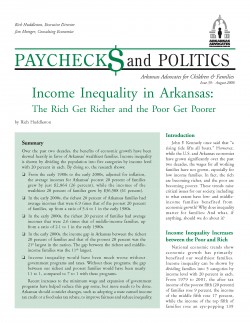
Over the past two decades, the benefits of economic growth have been skewed heavily in favor of Arkansas’ wealthiest families. Income inequality is shown by dividing the population into five categories by income level with 20 percent in each. By doing so, the research shows:
- From the early 1980s to the early 2000s, adjusted for inflation, the average incomes for Arkansas’ poorest 20 percent of families grew by just $2,864 (26 percent), while the incomes of the wealthiest 20 percent of families grew by $36,508 (61 percent).
- In the early 2000s, the richest 20 percent of Arkansas families had average incomes that were 6.9 times that of the poorest 20 percent of families, up from a ratio of 5.4 to 1 in the early 1980s.
- In the early 2000s, the richest 20 percent of families had average incomes that were 2.6 times that of middle-income families, up from a ratio of 2.1 to 1 in the early 1980s.
- In the early 2000s, the income gap in Arkansas between the richest 20 percent of families and that of the poorest 20 percent was the 21st largest in the nation. The gap between the richest and middle-income families was the 11th largest.
- Income inequality would have been much worse without government programs and taxes. Without these programs, the gap between our richest and poorest families would have been nearly 11 to 1, compared to 7 to 1 with these programs.
Recent increases to the minimum wage and expansion of government programs have helped reduce this gap some, but more needs to be done. Arkansas should consider changes, such as adopting a state earned income tax credit or a food sales tax rebate, to improve fairness and reduce inequality.
